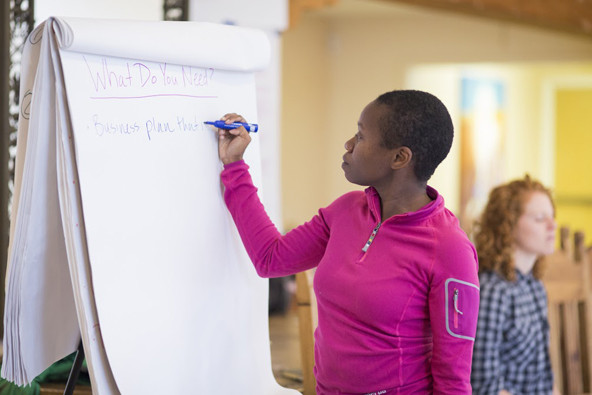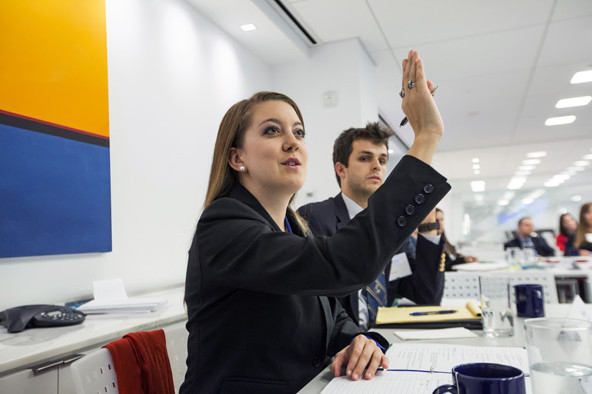Most academic programs and fellowships are designed with an emphasis on the experience and learning that participants will gain during their active enrollment. Yet this limited scope ignores an important reality: It’s after students leave campus that an education does its work.
The same is true in the social sector. As leadership accelerators like Echoing Green and national service programs like AmeriCorps proliferate, nonprofits focused on developing human capital need to recognize that if we approach alumni strategy as an afterthought, we will leave some of our greatest potential for impact unfulfilled.
Based on our experience at FoodCorps, the national service organization that brought us together as a funder (Davidson) and social entrepreneur (Ellis), here’s a look at the five common weaknesses built into many alumni programs and what the organizations running them can do better.
1. Great alumni programs aren’t about affinity; they’re about impact.
Are you enjoying this article? Read more like this, plus SSIR's full archive of content, when you subscribe.
The funder’s view: Nonprofits tend to put more focus on near-term program activities (“what we do”) than long-term strategy (“how we’ll achieve our mission”). Nowhere are the risks of this myopia more apparent than in the construction of alumni programs. Even in organizations with a cohesive theory of change, the vision for alumni usually revolves around stewarding them as donors, rather than activating them as lifelong change agents. The result: Alumni programs offer little beyond standard networking, job boards, and newsletters. What would it look like to orient alumni programs not toward a trip down memory lane, but toward addressing the problem that attracted them to the organization in the first place?
The FoodCorps approach: FoodCorps launched its first class six years ago: Fifty AmeriCorps members (this year’s group has 215) set out to connect kids to healthy food in high-need schools around the country. On the first day of orientation, we asked corps members to pose for pictures holding a chalkboard that explained why they had enrolled: “I believe every child deserves healthy food.” “I believe in full bellies and Jackson, Mississippi.” We then asked them to write a letter to themselves five years from then, envisioning what they wanted their futures to hold. This pushed corps members to enter their service looking for ways to turn their personal mission into a long-term profession. (We now incorporate a similar question into applications, starting this reflection process even earlier.)
Last summer, as we mailed those letters back to our FoodCorps pioneers, we were struck by how close our alumni have stayed to FoodCorps’ mission and goals, through the careers and education they’ve pursued since their service. In a survey of our most recent alumni class, we learned that 9 in 10 are in related fields, such as K–12 education, school food service, sustainable farming, and public health. Even more encouraging, 1 in 5 were hired directly by a FoodCorps school or partner following their service—more than half in newly created positions, such as school wellness coordinators, that institutionalize the changes they fostered as corps members. Alumni a few years out of service are climbing into increasingly influential jobs, such as district-level school food service directors and policy specialists with agencies like the US Department of Agriculture. When senior members of the FoodCorps staff traveled to Washington last fall to meet with the Secretary of Agriculture, a FoodCorps alumnus prepared his briefing book.
2. Recruit for the leaders you want as alumni, not just as participants in your program.
The funder’s view: Human capital organizations need to identify the phenotype they’re looking for—the set of unique attributes and soft skills that make an exceptional Acumen Fellow or AmeriCorps member. Leadership organizations have an aptitude for selecting participants who will succeed during the year or two they’re in the program, but few prioritize identifying those who will thrive in the decades after.
The FoodCorps approach: There’s an all-too-true stereotype in national service, of the affluent corps member who parachutes into a low-income community and proclaims: “I’m here to help you.” Recognizing the damage this model does to community self-reliance, FoodCorps saw that our early classes were overwhelmingly white and privileged, so we established strategies and practices to recruit corps members from within the low-income communities we serve and to invest in the development of leaders who are likely to stay in these communities. Today, 78 percent of our corps members are serving in the state they call home, and a growing number are serving in the very schools they attended as children. The challenge is ongoing—33 percent of today’s FoodCorps members are people of color, compared to 71 percent of the students we reach—but we are committed to continued progress. Corps members who share backgrounds, identities, or life experiences with the kids they’re serving aren’t just more effective during service; they rarely leave those communities behind.
3. Offer your alumni more than you ask from them, and you’ll get much more in return.
The funder’s view: Many of us in the philanthropic community are members of a range of alumni networks, and most of us agree: These institutions sure seem focused on opportunities for us to donate! It’s not that alumni programs shouldn’t be seen as economic engines—they are and need to be—but those engines would run a lot more smoothly (and I’d donate a lot more enthusiastically!) if they offered a contemporary value proposition—not just a historical one—for why I should care about them.
 FoodCorps staff member Tiffany McClain leads a session at the Alumni of Color Retreat and Training. (Photo by Gabriella Marks for FoodCorps)
FoodCorps staff member Tiffany McClain leads a session at the Alumni of Color Retreat and Training. (Photo by Gabriella Marks for FoodCorps)
The FoodCorps approach: We want our alumni to be active participants in FoodCorps long after their service. In 2016, we hosted an Alumni Policy Institute, convening a dozen FoodCorps alumni for a multi-day advocacy training, then working with them to orchestrate a Capitol Hill fly-in for 60 school food advocates they had recruited from their home communities. Together, they could lobby for healthier school meals. We convened an Alumni of Color Cohort as well, investing in the storytelling and leadership skills of alumni who bring much-needed diversity to their fields. We share job opportunities weekly, offering coaching and introductions to help them compete. Next, we’re introducing a series of in-depth career trainings to propel these emerging leaders into fulfilling and influential career paths—as school food directors, healthy food educators, and policy reformers—that align with FoodCorps’ mission and goals.
 FoodCorps Alumni Rachel Spencer and Nicholas Geer participate in the FoodCorps Alumni Policy Training Institute. (Photo by Eva Russo for FoodCorps)
FoodCorps Alumni Rachel Spencer and Nicholas Geer participate in the FoodCorps Alumni Policy Training Institute. (Photo by Eva Russo for FoodCorps)
These investments cost money, but they accelerate our impact—and pay a dividend. When we asked our alumni whether they would make FoodCorps a top-five priority in their personal charitable giving, more than half said yes, and one in five volunteered to fundraise for us. When alumni see themselves as part of the change we strive to achieve, they are far more likely to own the mission and their role in it.
4. Build your alumni program before you have alumni.
The funder’s view: The challenges of starting a nonprofit are so big and so varied that alumni programming often falls to the backburner. But every established human capital organization I’ve spoken with has expressed the same regret: “Why didn’t we do this sooner?” So when FoodCorps came to us seeking a renewal of the support our foundation had given them, we were enthusiastic about signing on—but only if they made a significant investment in taking their nascent alumni program to the next level, now.
The FoodCorps approach: At the Woodcock Foundation’s encouragement, and with its support, FoodCorps created a fulltime alumni manager position at a time when we still had more active corps members in the field than alumni. We filled that role with a standout FoodCorps alumna from our first class, who went on to shape the purposeful program we have today. Our alumni cohort will surpass 500 members this year, a vibrant network we continually engage—not only through opportunities for their own professional and personal development, but also by facilitating intergenerational support and inspiration for current corps members, bringing on accomplished alumni as trainers, career panelists, and peer mentors. All the while, we’ve been able to encourage our earliest members to grow with FoodCorps, rather than away from it.
5. Accept that building a great alumni program is hard.
The funder’s view: The Woodcock Foundation invests in leadership development, because we see few philanthropies doing it—and I understand why. We like to believe that the nonprofit sector can be more patient about seeing returns than the for-profit world, but in the competitive climate for funding, that’s wishful thinking. Impact from leadership development is difficult to measure. It takes time, and it’s a tough sell to prospective funders. Yet funders willing to take the long view on impact need to invest in both creating change and the messy work of creating change-makers.
The FoodCorps approach: Even after six years, our alumni strategy is a work in progress. We are redoubling our efforts to build a diverse service force that is connected to the high-need communities we serve. We are taking steps to guide our alumni toward fulfilling careers that have real impact. And we are engaging alumni to give back in ways that are meaningful to them—whether through mentoring current corps members, advocating for the protection of national service funding, or volunteering in FoodCorps schools.
The ways you can prepare for, serve, and leverage your alumni are limitless, but one task is vital: Start early and with intention. The earlier you begin to engage alumni meaningfully, the greater influence you’ll have on their involvement, their development, and your own organization’s future.
Keep in mind: As we recruit and train corps members, fellows, students, or other groups, we’re not only nurturing future alumni for our organizations—we’re cultivating the next generation of leaders for our causes. By investing purposefully in the promise of these individuals, we are creating a succession plan on a movement-wide scale: identifying and shaping the very people who will one day take the reins and make our visions of a more just, healthful, and sustainable future a reality.
Support SSIR’s coverage of cross-sector solutions to global challenges.
Help us further the reach of innovative ideas. Donate today.
Read more stories by Curt Ellis & Stuart Davidson.

